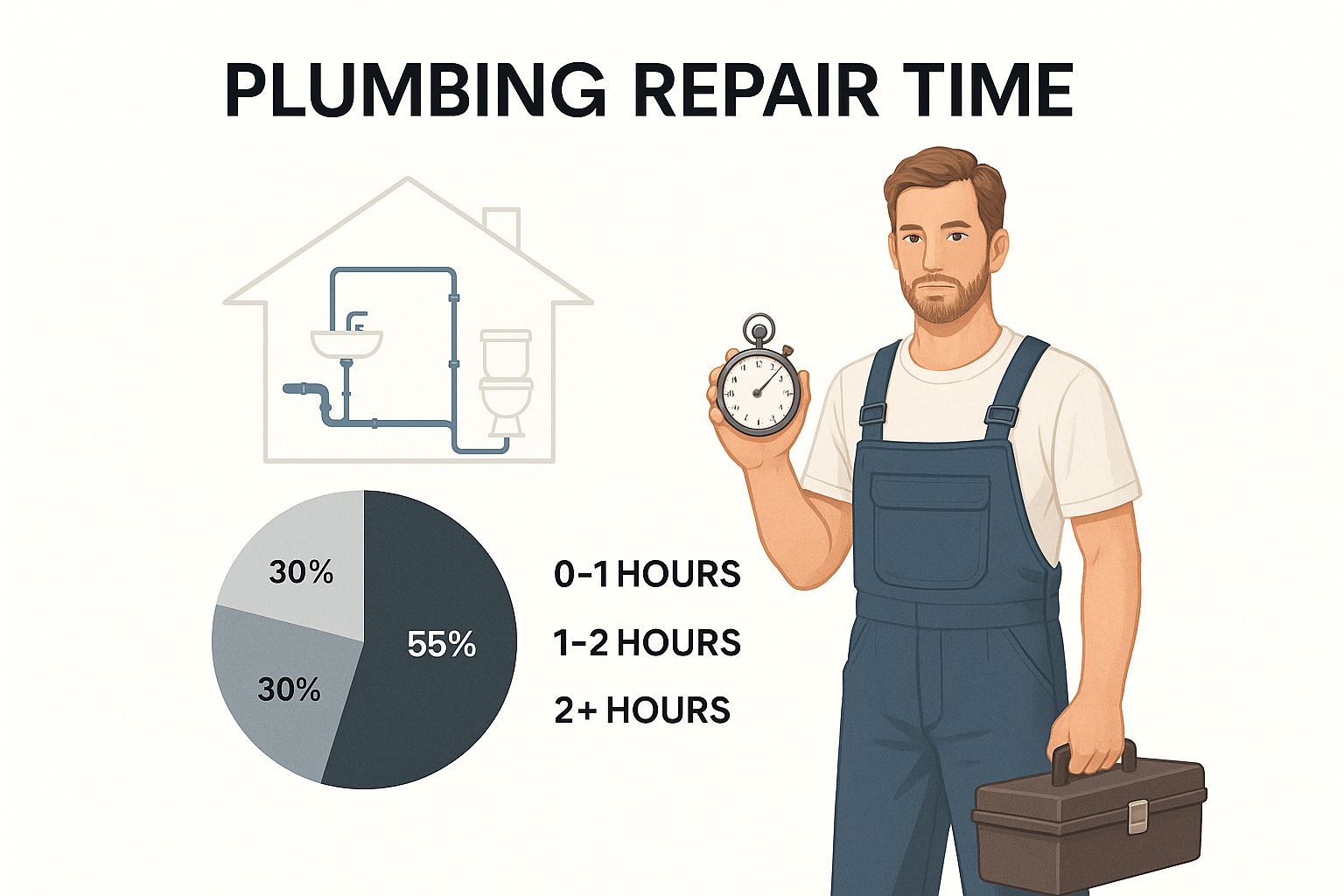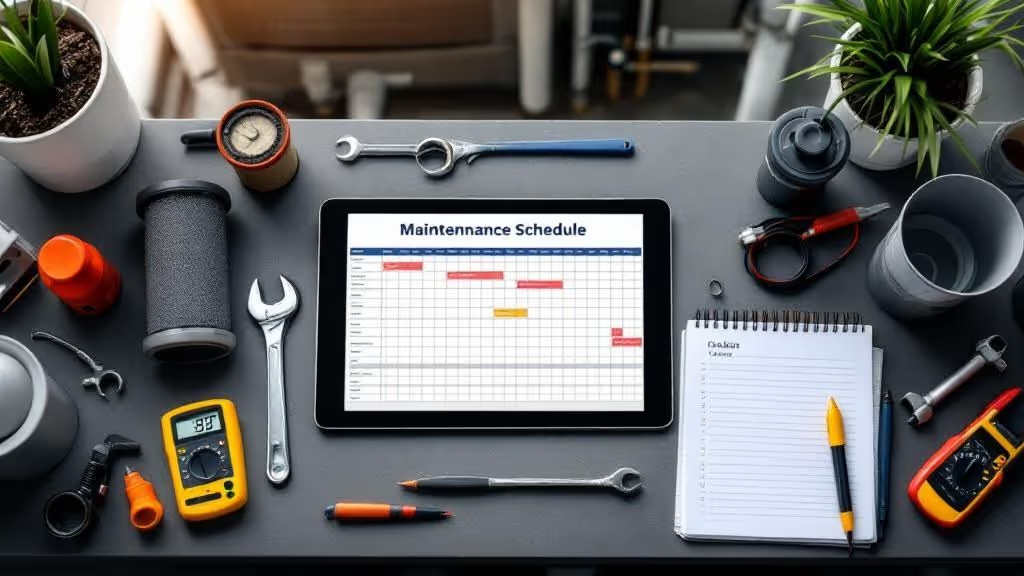The only way to consistently make money on plumbing jobs is to know your numbers inside and out. You need to calculate your true costs—labor, materials, and overhead—and then add a specific profit margin on top. Anything else is just guesswork, and guesswork is a surefire way to end up in the red.
This guide will walk you through building that formula so every quote you send is a profitable one.
The Blueprint For Profitable Plumbing Prices
Before you can confidently price any job, you need a solid blueprint. Simply matching a competitor's price or quoting what "feels right" is a fast track to financial trouble. For your business to grow and thrive, you need a system for every single estimate.
Having a system means you can be proactive, not reactive. Each job shouldn't just cover its own direct expenses; it has to contribute its fair share to keeping the lights on and fueling future growth. This is how you build a resilient, financially healthy company.
Moving Beyond Guesswork
Your pricing strategy says a lot about your professionalism. A well-structured quote, backed by real numbers, builds trust with customers. On the other hand, a number that seems pulled from thin air can create doubt and invite haggling. When you truly understand your costs, you can justify your price with confidence and shift the conversation from "how much?" to the long-term value you provide.
This all comes down to a few key things:
- Cost Analysis: You have to account for everything. That means the plumber's time, the van's fuel, and even the smallest tube of sealant.
- Profit Planning: Profit isn't what's leftover. It's a line item you plan for from the very beginning to grow your business.
- Customer Communication: Your quote needs to be clear and transparent. When customers understand what they're paying for, they're more likely to appreciate the value.
As you develop this pricing blueprint, it also helps to understand the bigger picture of home improvement projects. Knowing the typical kitchen renovation costs, for instance, gives you valuable context for larger plumbing installations.
Choosing Your Pricing Model
How you present your price to the customer is just as important as how you calculate it. You need a model that makes sense for the job at hand. Should you charge by the hour, or give a single, all-in price? The right answer depends entirely on the type of work.
Here’s a breakdown of the two most common approaches to help you decide.
Choosing Your Pricing Model
Having both models in your toolkit gives you the flexibility to price jobs accurately and fairly, which is a win-win for both you and your customer.
Deciding Between Flat-Rate And Hourly
Let’s look at some real-world numbers. Small jobs, like unclogging a sink or fixing a leaky tap, typically cost a homeowner between $125 and $350. These common repairs make up a huge chunk of service calls—around 80%—and are perfect for a flat-rate pricing model.
A flat-rate price gives the customer peace of mind because they know the final cost upfront. For you, it rewards efficiency. If you've done the job a hundred times and can get it done faster than average, your profit margin on that job goes up.
On the flip side, you have bigger, more complex projects. Things like replacing a water heater or dealing with a burst pipe can easily run from $500 to $800 or more. These jobs are often full of unknowns, making a "time and materials" approach a much safer bet. This protects you if you run into unexpected problems behind a wall, ensuring you're compensated for the extra work. For more on how these costs break down, you can explore detailed plumbing cost statistics.
Figuring Out Your True Labor Cost

Your team's time is your biggest asset, but if you're just using a simple hourly wage to price jobs, you're leaving money on the table. It's one of the most common mistakes I see. To price for real profit, you have to know your fully loaded labor rate—the actual, total cost to your business for every single hour one of your plumbers is on the clock.
Think of it this way: what you pay your plumber is just the beginning. On top of that wage, you've got a stack of other essential costs that come with having an employee. These "indirect" costs can silently chew through your profits if you don't account for them in every quote.
What's Really in a Loaded Labor Rate?
The fully loaded rate isn't just the wage. It’s a complete number that includes the direct pay plus all the "burden" costs—everything you have to pay just to keep that plumber on your payroll.
Your calculation absolutely must include these key pieces:
- Base Hourly Wage: This is the straightforward part—what you pay your plumber per hour.
- Payroll Taxes: You can't forget Social Security, Medicare (FICA), and federal and state unemployment taxes (FUTA/SUTA).
- Workers' Compensation: A big one in the trades. This is the insurance premium you pay to cover potential on-the-job injuries, and it's not cheap.
- Employee Benefits: Think health insurance, dental plans, retirement contributions (like a 401(k) match), and any paid time off (PTO).
If you miss even one of these, you're underestimating your true labor cost. That means your quotes are wrong from the start, and your bottom line will suffer.
Key Takeaway: Your loaded labor rate is the bedrock of your entire pricing strategy. Getting this number right is the first, most critical step to making sure every job you take on is actually profitable.
A Real-World Calculation
Let's walk through how this looks in practice. Say you have a great technician, Alex, who you pay $35 per hour.
Now, let's add the labor burden. The exact percentage varies, but from my experience, burden costs typically add 25% to 40% on top of the base wage. For this example, let's say Alex's burden costs—all his taxes, insurance, and benefits—come out to 30% of his wage.
- Burden Cost: $35 (hourly wage) x 0.30 (burden percentage) = $10.50 per hour
- Fully Loaded Rate: $35 (hourly wage) + $10.50 (burden cost) = $45.50 per hour
That $45.50 is your actual cost for every hour Alex is working. It's the bare minimum you have to charge just to break even on his time, and that's before you've even thought about materials, overhead, or making a profit.
Why You Need Tiered Rates for Different Skill Levels
Your master plumber tackling a complex boiler install isn't the same as an apprentice snaking a drain. They bring different skills, work at different speeds, and cost your business different amounts. A one-size-fits-all labor rate just doesn't make sense.
This is why smart plumbing businesses develop a tiered rate structure. You should have different loaded rates for each skill level on your team.
- Apprentice Plumber: A lower rate that reflects their wage and the fact they're still learning.
- Journeyman Plumber: A solid mid-tier rate for your experienced, independent techs who handle the bulk of the work.
- Master Plumber: A premium rate for your top experts handling the most complex, high-stakes jobs.
A tiered system lets you price jobs more accurately and competitively. You can send the right person for the job without overcharging for simple tasks or, even worse, undercharging for difficult ones.
Of course, these are your internal cost figures. The final rate you bill the customer is a different story. The market rate for plumbing services is all over the map. In 2025, the U.S. average hovers around $90 per hour, but it can swing from $45 to $200 based on the job's complexity and your location. Emergency calls can push rates toward $300 an hour, and plumbers in big cities often charge 30-50% more than those in rural areas. For a deeper look at what customers are paying, check out this analysis of plumber hourly rates.
By building your quotes on a detailed, tiered labor cost, you ensure every price reflects the true value and cost of your team's expertise.
Marking Up Materials For Maximum Profit
Your labor is just one piece of the profitability puzzle. How you handle the cost of parts and supplies can make or break your bottom line. I see too many new plumbers make the rookie mistake of slapping a flat 20% markup on everything. Honestly, that's just leaving money on the table.
To really maximize what you earn, you need to get smarter about pricing materials. It's not about a one-size-fits-all formula. The secret lies in a tiered markup strategy, where you treat different types of materials differently. This is how you balance making a healthy profit with keeping your customers happy about the value you provide.
The Power Of Tiered Markups
So, what is a tiered system? It’s pretty simple in concept: you apply a higher markup percentage to cheap, common parts and a much lower percentage to expensive, big-ticket items. This lets you make great money on the everyday stuff without looking like you’re price-gouging on a new water heater.
Think about it this way. A 200% markup on a $5 PVC fitting only adds $10 to the customer's bill. That’s a completely fair price for having the exact right part on hand, saving them a trip to the hardware store. But if you tried to apply that same 200% to a $900 water heater, you'd be adding $1,800 to the price. Your customer would be on the phone getting other quotes before you even finished writing the estimate.
Strategic planning, from scheduling your time to choosing the right parts, is what separates a struggling plumber from a truly profitable one.

The takeaway here is that every single component of a job, no matter how small, adds up. When you manage each piece correctly, you build a profitable final price.
Building Your Markup Tiers
To make this work, you need to set up some clear rules. Define your cost brackets and assign a markup percentage to each one. This ensures you’re consistent and fair with every quote you create.
Here’s a practical example of a tiered material markup strategy I've seen work well. It's a great starting point for figuring out how to price plumbing jobs in your own business.
Example Tiered Material Markup Strategy
This table breaks down how you can apply different markups to different cost tiers. It's designed to maximize your profit on smaller items while keeping you competitive on larger purchases.
This structure allows you to build in healthy margins where customers won't notice and stay competitive where they’re most price-sensitive. You can, and should, adjust these percentages to fit your local market and business costs.
Don't Sweat The Small Stuff—Bill For It
One of the sneakiest ways plumbers lose money is by ignoring the consumables. All those little things—solder, thread sealant, primer, glue, screws, and fasteners—quietly chip away at your profits. They might seem insignificant on one job, but over the course of a year, the costs can be substantial.
Pro Tip: Bundle these consumables into your job costs. My advice is to add a small, standard "sundries fee" to every single service call. Another way is to just slightly increase your overall material markups to absorb the cost.
Whatever you do, don't give these items away for free. They are a real cost of doing business, and you have to account for them to protect your profit margins.
Finally, don't underestimate the power of your relationship with suppliers. Talk to your reps regularly. When you're buying in volume, you have leverage—don't be afraid to negotiate for better pricing. Shaving even 5% off your cost for a common fixture can add thousands to your bottom line over the year. Being proactive about your supply costs is one of the best ways to build a more resilient and profitable business.
Uncovering and Covering Your Overhead Costs

Okay, so you've got a handle on your labor and material costs. That's a great start, but it only covers the direct expenses tied to a specific project. What about everything else? What about the costs that keep your business afloat day in and day out, whether you're on-site or back at the shop?
These are your overhead costs, and frankly, they're the number one thing plumbers forget to account for when pricing jobs.
Ignoring overhead is the quickest way to find yourself in a financial hole. It's like trying to fill a bucket with a leak—no matter how much revenue you pour in from jobs, that money is constantly trickling out. Every single quote you send out has to carry its share of these costs. If it doesn't, you're literally paying for the privilege of working.
Identifying Every Single Overhead Expense
First things first, you need an honest, exhaustive list of every single thing you pay for to keep the lights on and the van on the road. Some of these costs are fixed every month, while others might change. The goal here is to leave no stone unturned, no matter how small an expense seems.
Your list of business expenses will be unique to your operation, but it’s going to include things like this:
- Vehicle Costs: This is a big one. We're talking truck payments or leases, fuel, insurance, registration, and all the maintenance—from oil changes and new tyres to those surprise repairs that always pop up.
- Shop and Office Expenses: If you have a physical base, you need to factor in the rent or mortgage payments, all utilities (power, water, internet), and property taxes.
- Software and Tech: Let's face it, this list keeps growing. It includes your accounting software like QuickBooks or Xero, your field service management (FSM) platform, GPS subscriptions, and mobile phone bills.
- Insurance and Licensing: Don't forget general liability insurance, business licenses, and any required permits or bonds. These are the non-negotiable costs of doing business legally and protecting yourself.
- Marketing and Advertising: How are customers finding you? This bucket includes your website hosting, any online ad spend, vehicle wraps, branded uniforms, and even business cards.
- Admin Support: If you have someone in the office handling calls and scheduling, their salary and benefits are a major overhead cost. Even if you’re doing it all yourself, that time has value.
I know, that list can feel a bit daunting. But getting it all down on paper is a massive step toward real financial clarity.
Remember, these are the costs of being in business, not the costs of a specific job. Each job must pay its fair share to cover them. This mindset shift is crucial when learning how to price plumbing jobs for true profitability.
Calculating Your Overhead Recovery Rate
Once you've got a complete list of your monthly overhead expenses, you need to translate that total into a practical number you can use for every single quote. This is what we call an overhead recovery rate—it’s the amount you’ll add to every billable hour to make sure your business expenses are covered.
Let's walk through a simple, real-world example.
Let's say after adding everything up, your total monthly overhead comes to $8,000. Now, the next crucial piece of the puzzle is figuring out how many billable hours your team actually works in a month. And I stress billable hours—this is only the time you can charge a customer for. It doesn't include driving to the supplier, grabbing parts, or organising the van.
Imagine you have two plumbers on your team, and each one realistically logs about 120 billable hours per month.
- Total Monthly Billable Hours: 2 plumbers x 120 hours/plumber = 240 billable hours
Now for the simple math that makes all the difference.
- Calculation: $8,000 (Total Monthly Overhead) ÷ 240 (Total Billable Hours) = $33.33 per hour
That $33.33 is your magic number. For every hour you bill a client, you must add this amount on top of your labor rate and material costs just to break even on your overhead. If you forget to add this, you're losing $33.33 for every single hour your team works. Nailing this calculation is often the difference between just surviving and actually thriving as a plumbing contractor.
Building a Healthy Profit Margin into Every Job
Once you've tallied up your loaded labor, marked-up materials, and overhead, you’ve found your breakeven point. That's the bare minimum you need to charge just to cover your costs for that specific job and keep the lights on back at the shop. But here’s the thing: breaking even doesn't build a business. Profit does.
Too many contractors fall into the trap of thinking profit is just whatever’s left in the bank account at the end of the month. That’s a dangerous way to run a company. Real, sustainable profit isn't an accident; it's a line item you have to deliberately build into every single estimate, right from the start.
Profit Is Not Your Salary
Let's clear up a common—and critical—misconception: your profit margin and your salary are two entirely separate things. Your salary is an operational expense. It's what pays your mortgage and compensates you for the actual work you do, and it should already be baked into your overhead calculations.
Profit belongs to the business. Think of it as the fuel for growth, stability, and future opportunities.
Profit is what lets you invest back into your company. It’s the cash you use to finally buy that new, more efficient jetter, send your crew for advanced training, add another truck to the fleet, or just build up a healthy cash reserve so a slow month doesn't send you into a panic.
Without intentionally planning for profit, your business will just tread water. You'll be stuck in a frustrating cycle of "just getting by," unable to make the investments you need to work smarter, serve more customers, and ultimately, earn more.
Setting Your Target Profit Margin
So, what's the magic number for profit? While there's no universal answer, a solid target for most plumbing businesses is somewhere between 10% and 20%. This isn't set in stone, though; it can and should move depending on your market and the kind of work you do.
For example, if your bread and butter is high-volume, standard service calls, you might aim for a consistent 15% on every job. But if you specialize in complex, high-end custom remodels or offer 24/7 emergency services, you can easily justify pushing that margin to 25% or more. You're charging for premium value and higher risk, and your profit should reflect that.
Here’s how you put it all together to get your final price:
- Job Subtotal: Loaded Labor Cost + Marked-Up Material Cost + Overhead Recovery
- Profit Amount: Job Subtotal x Your Target Profit %
- Final Price to Customer: Job Subtotal + Profit Amount
This simple formula ensures every job doesn't just pay today's bills, but also helps fund your company's future.
Aligning Profit with Your Brand
Your profit margin is more than just a number on a spreadsheet—it's a strategic decision that shapes how customers see your brand.
Are you the reliable, go-to expert for everyday plumbing needs in your community? A slightly lower margin built for high volume might be your play. Or do you want to be known as the premium, can-fix-anything-at-any-time emergency service? A higher profit margin is completely justified by the incredible value and peace of mind you deliver.
In the end, pricing your work effectively boils down to confidence. When you know your numbers inside and out—from your true labor cost to your exact overhead—you can present your final price with total certainty. You're not just throwing out a number; you're presenting a value backed by a solid financial plan. That confidence is what allows you to charge what you're worth and secure the profit you need to build a resilient, thriving business.
Frequently Asked Questions About Pricing Plumbing Jobs
Even with the best formulas on paper, things get messy out in the field. Questions always come up, and how you handle them can make or break your profitability and your reputation with customers. Honestly, getting your pricing just right is a skill you'll refine for your entire career.
Let's dive into some of the most common questions I hear from fellow plumbers and break down some real-world answers you can use on your very next call.
Should I Use Flat-Rate Pricing or Hourly Rates?
The smartest plumbing businesses don't stick to just one. They use both. Think of flat-rate and hourly billing as two different tools in your belt—you need to know when to grab the right one for the job at hand.
For your bread-and-butter, predictable jobs, flat-rate pricing is the way to go. I’m talking about work like:
- Swapping out a kitchen faucet.
- Clearing a standard sink or toilet clog.
- Popping in a new garbage disposal.
With a flat-rate price, the customer knows the total cost upfront, which is a huge trust-builder. It also rewards you for being good at what you do. If your seasoned tech can replace that faucet in 45 minutes instead of the book-time of 90, your profit for that hour just shot through the roof.
But for jobs full of unknowns, flat-rate is a gamble. That’s where hourly rates, or Time & Materials (T&M), become your safety net.
Save hourly billing for these situations:
- Leak detection and other diagnostic jobs.
- Big remodels where you don't know what's hiding behind the drywall.
- Any project where the scope is fuzzy from the start.
This protects you from those nasty surprises that can tank your profit on a job. Many of the best plumbers I know run a hybrid system. They’ll have a digital price book packed with flat-rate options for routine repairs, but they'll switch over to hourly billing for custom work and troubleshooting.
How Do I Justify My Price When a Customer Says It Is Too High?
Every contractor gets this question, and it's easy to get defensive. Don't. See it as your chance to demonstrate your value, not just defend a number on a page.
When a homeowner balks at the price, your job is to shift the conversation from cost to value. You need to confidently explain what's inside that number.
Try saying something like this: "I understand it's a significant investment. Our price isn't just for the parts and the time I'm here today. It includes the peace of mind that comes from hiring a licensed, insured professional to work in your home. We only use high-quality materials that won't fail you in six months, and we back up all our work with a solid guarantee."
Key Insight: You're not just selling plumbing services; you're selling peace of mind. They are paying for reliability, safety, and the confidence that the job is done right the first time.
Remember, your professionalism justifies your price before you even open your mouth. A clean truck, a professional uniform, and a detailed, easy-to-read quote all send a powerful message: you're an expert, not a handyman, and you're worth the investment.
What Software Can Make My Job Pricing Easier?
Ditching the old pen-and-paper estimate is probably the single biggest leap you can make for your business's accuracy and profitability. Modern field service management (FSM) software is built specifically to solve this exact problem for tradespeople like us.
Platforms like Jobber, Housecall Pro, and ServiceTitan are designed to handle your entire pricing workflow. The real magic is setting up a digital price book where all your critical numbers are pre-loaded.
Imagine a system where:
- Your fully-loaded labor rates are already calculated.
- Material markups are applied automatically based on your tiers.
- Overhead costs are built right into every single estimate.
- Your target profit margin is included by default.
When you need to build a quote, you just tap to select the services and parts. The software does the math on the spot, creating a professional and—most importantly—profitable estimate in seconds. This virtually eliminates costly math errors and gives you back hours of your time.
Down the road, this software gives you incredible insight. You can look at the data and see exactly which jobs are making you the most money, helping you focus your efforts on the work that will actually grow your business.
Manually tracking job details through texts and calls is a recipe for missed details and wasted time. ResQ’s Nora is an AI assistant that lets your field crew send job notes, photos, and voice memos right from WhatsApp. Nora neatly organizes everything into clean, actionable logs, giving your office team the accurate info they need for invoicing and follow-ups. Stop chasing down details and start streamlining your operations. See how Nora can transform your workflow.



